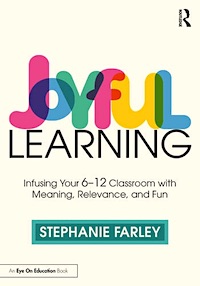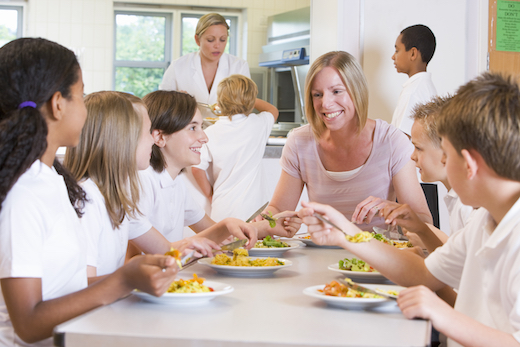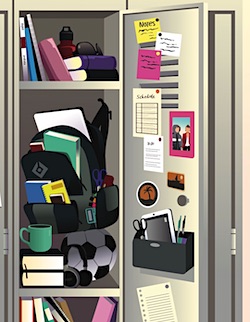What Does an Assistant Principal Do Again?
By Stephanie Farley

Our message was “school is a place to be happy,” and to convey this theme we had created a video in which all of the middle school teachers and staff danced around to the song “Happy” by Pharrell Williams.
The video production was a family affair, as my husband directed and edited the video while my younger daughter jumped around in the video dressed as a cheerleader.
I couldn’t wait to show our work to the students in the first-day-of-school assembly. The reaction was even better than I’d hoped, as the kids roared in approval when the video finished and clamored to watch it again.
Walking away from that assembly, my heart was full. I felt we had accomplished a major goal: the video communicated the message that the faculty and staff cared about students having a joyful school experience.
As the assistant principal, I found students often asked me what exactly I did all day. They knew the principal ran the school, but what does an assistant principal do? Make videos! I said.
I might have added that, in my spare time, I tried to make sure that kids, teachers, and families had what they needed to be successful and joyful. To do that, I developed a 3-step approach to my job as assistant principal. I needed to:
- Show up
- Listen deeply
- Chill out
When I shared this list with students, they often nodded wisely and said something like “that’s fire.” For those of you who also find yourself in the position of trying to make sure everyone has what they need, I’ll explain the 3 steps.
1. Show Up
Showing up is all about being in the present moment. In today’s parlance, we might talk about bringing one’s full self to the task. But it also means, literally, “show up.” While it wasn’t a supervisory assignment, I made it my job to be out with the students during lunch. This visibility signaled, “Hey, I’m here if you need anything.”
My loitering paid off: in “school culture” surveys students indicated that having a principal-type person visible during lunch contributed to their sense of safety. Additionally, I gladly met with any person who wandered by and wanted to chat. I relied on these usually quick, informal meetings to understand the concerns of the community.
Showing up also means equipping yourself with a variety of strategies to deal with the issues that arise in a school. In my case, I read about learning differences, brain science, implicit bias, positive psychology, student choice, alternative assessment models, and diversity, equity, and inclusion – and experimented with what I learned in my own classes.
Oh yeah…find a way to teach! There’s really nothing more frustrating than being told what to do by a person who hasn’t done it (or isn’t doing it) themselves. So figure out how you can have consistent time with students and resist the preaching of new ideas until you’ve practiced them with those students.
Showing up is standing in the classroom when a teacher needs to use the restroom and standing shoulder-to-shoulder with the teacher when an angry parent appears brandishing a long list of complaints. It’s listening to the parent who’s upset and figuring out the crux of the issue without allowing the parent’s emotionality to overwhelm you or distort your decision-making. It’s also finding a solution, with the teacher, that balances the needs of student, family, teacher, and school.
Further, showing up means keeping the big picture in mind even as you dive into the details. In one school I visited, I kept hearing from teachers that students were more emotionally unstable than they were a few years ago, pre-pandemic.
When I asked about the SEL program at the school, the teachers shook their heads. There was no SEL program. Any social-emotional learning components were up to the teachers, who snatched minutes from other instruction to get time for an SEL activity.
Principals (perhaps at the urging of APs) can show up by scheduling a weekly, 30-minute SEL activity. Create a choice board for the teachers and provide all the materials, pre-packaged and ready to go, so the only thing teachers have to worry about is selecting an activity that suits the needs of the particular day.
Finally, showing up is attending all the boring meetings so that you can advocate for teachers and students. Your presence matters.
2. Listen Deeply
Years ago, I attended a workshop on deep listening with counselors from the Stanley King Institute. They were extraordinary. It was so helpful to me in all of my roles, but it was transformational in my ability to be an effective assistant principal.
Here’s why: deep listening is the antithesis of modern life, which is twitchy and only half paying attention. Deep listening means that, instead of speaking, you commit yourself to hearing what others say and confirming that you truly understand both the text and subtext. My procedure as an assistant principal looked this this:
1. When someone (teacher, student or parent) came to talk with me, I pulled out a notebook and took notes as they spoke. I listened, nodded, and repeated their words, asking them to confirm I had captured the words exactly.
2. Next, I summarized what was said and asked clarifying questions when I got something wrong (if you’re counting, yes, that’s two times I repeated what was said to me, and yes, that’s deliberate).
3. After that, I waited. It’s hard to wait. The temptation is to rush into the silence and say something – anything! – so we can assert ourselves as a person of agency. But silence is okay. It gives everyone a chance to think. Especially, it gave kids a chance to think about what they wanted me to do with the information they’d shared.
For some folks, deep listening can be deeply annoying because it’s not action-oriented. There’s no judgment being delivered. Instead, it’s quiet and intense, which is perfect for chilling out.
3. Chill Out
Chilling out, for me, means using empathy, compassion, and creativity to guide decision-making. Empathy is required to understand the needs of students, teachers, and families, while compassion and creativity are required to develop the programs, classes, and policies to serve those needs.
One example of a chilled-out decision governed by compassion was when a student broke a pretty serious rule on the last day of school. He was remorseful and eager to make amends, so he volunteered to clean out lockers after everyone had left for the summer.
The student felt this was a concrete way for him to give back, and ultimately he said he enjoyed the physical nature of the task. Some kids would have felt cleaning out lockers was cruel and unusual punishment. When students have choices about how they repair the community, the results can be profound.
Chilling out is also about creating the conditions in which everyone can chill out, which you do by allowing joy to thrive. Joy grows when students and teachers:
● Experience a sense of belonging
● Feel that what they say matters
● See that their strengths have value and purpose
● Know that they can have fun at school.
The specific form joy takes depends on your school. At my school we not only made videos, but the teachers also prepared flash mob-style dances to perform for the students, created large scale community events like political conventions, and taught students how to contact politicians to urge action on issues like homelessness, LGBTQ rights, and climate change.
My role in all of this was to make the resources available, chill out, and savor the authentic learning happening around me. When you show up, listen, and chill out, kids, teachers, and families understand that the assistant principal is actually an agent of joy.

Stephanie’s book, Joyful Learning: Tools to Infuse Your 6-12 Classroom with Meaning, Relevance, and Fun, will be published in April, 2023. She has created professional development for schools around reading and curriculum and coaches teachers in instruction, lesson planning, feedback, and assessment. Visit her website Joyful Learning and find her other MiddleWeb articles here.







































BIG YES to continued classroom teaching! As a principal, it can be easy to lose touch, not know how to help, or even to become dispassionate. Teaching is a game changer for happy and effective principals. Great post!